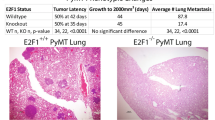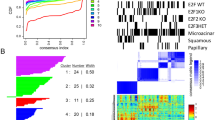Abstract
HER2/Neu is amplified and overexpressed in a large proportion of human breast cancers, but the signaling pathways that contribute to tumor development and metastatic progression are not completely understood. Using gene expression data and pathway signatures, we predicted a role for activator E2F transcription factors in Neu-induced tumors. This was genetically tested by interbreeding Neu transgenics with knockouts of the three activator E2Fs. Loss of any E2F delayed Neu-induced tumor onset. E2F1 loss accelerated tumor growth, while E2F2 and E2F3 loss did not. Strikingly, it was observed that loss of E2F1 or E2F2 significantly reduced the metastatic capacity of the tumor and this was associated with a reduction in circulating tumor cells in the E2F2 knockout. Gene expression analysis between the tumors in the various E2F-mutant backgrounds revealed that there was extensive compensation by other E2F family members in the individual knockouts, underscoring the importance of the E2Fs in HER2/Neu-induced tumors. Extension to HER2-positive (HER2+) human breast cancer revealed a number of HER2+ subtypes based on E2F activity with differences in relapse-free survival times. Taken together, these data demonstrate that the E2F transcription factors are integral to HER2+ tumor development and progression.
This is a preview of subscription content, access via your institution
Access options
Subscribe to this journal
Receive 50 print issues and online access
$259.00 per year
only $5.18 per issue
Buy this article
- Purchase on Springer Link
- Instant access to full article PDF
Prices may be subject to local taxes which are calculated during checkout






Similar content being viewed by others
References
Slamon DJ, Clark GM, Wong SG, Levin WJ, Ullrich A, McGuire WL . Human breast cancer: correlation of relapse and survival with amplification of the HER-2/neu oncogene. Science 1987; 235: 177–182.
Slamon DJ, Godolphin W, Jones LA, Holt JA, Wong SG, Keith DE et al. Studies of the HER-2/neu proto-oncogene in human breast and ovarian cancer. Science 1989; 244: 707–712.
Eccles SA . The role of c-erbB-2/HER2/neu in breast cancer progression and metastasis. J Mammary Gland Biol Neoplasia 2001; 6: 393–406.
Dankort DL, Wang Z, Blackmore V, Moran MF, Muller WJ . Distinct tyrosine autophosphorylation sites negatively and positively modulate neu-mediated transformation. Mol Cell Biol 1997; 17: 5410–5425.
Prigent SA, Gullick WJ . Identification of c-erbB-3 binding sites for phosphatidylinositol 3'-kinase and SHC using an EGF receptor/c-erbB-3 chimera. EMBO J 1994; 13: 2831–2841.
Soltoff SP, Carraway KL 3rd, Prigent SA, Gullick WG, Cantley LC . ErbB3 is involved in activation of phosphatidylinositol 3-kinase by epidermal growth factor. Mol Cell Biol 1994; 14: 3550–3558.
Ren Z, Schaefer TS . ErbB-2 activates Stat3 alpha in a Src- and JAK2-dependent manner. J Biol Chem 2002; 277: 38486–38493.
Lin NU, Winer EP . Brain metastases: the HER2 paradigm. Clin Cancer Res 2007; 13: 1648–1655.
Sears RC, Nevins JR . Signaling networks that link cell proliferation and cell fate. J Biol Chem 2002; 277: 11617–11620.
Muller WJ, Sinn E, Pattengale PK, Wallace R, Leder P . Single-step induction of mammary adenocarcinoma in transgenic mice bearing the activated c-neu oncogene. Cell 1998; 54: 105–115.
Guy CT, Webster MA, Schaller M, Parsons TJ, Cardiff RD, Muller WJ . Expression of the neu protooncogene in the mammary epithelium of transgenic mice induces metastatic disease. Proc Natl Acad Sci USA 1992; 89: 10578–10582.
Yu Q, Geng Y, Sicinski P . Specific protection against breast cancers by cyclin D1 ablation. Nature 2001; 411: 1017–1021.
Dyson N . The regulation of E2F by pRB-family proteins. Genes Dev 1998; 12: 2245–2262.
DeGregori J, Johnson DG . Distinct and overlapping roles for E2F family members in transcription, proliferation and apoptosis. Curr Mol Med 2006; 6: 739–748.
Leone G, Sears R, Huang E, Rempel R, Nuckolls F, Park CH et al. Myc requires distinct E2F activities to induce S phase and apoptosis. Mol Cell 2001; 8: 105–113.
Ziebold U, Lee EY, Bronson RT, Lees JA . E2F3 loss has opposing effects on different pRB-deficient tumors, resulting in suppression of pituitary tumors but metastasis of medullary thyroid carcinomas. Mol Cell Biol 2003; 23: 6542–6552.
Andrechek ER, Mori S, Rempel RE, Chang JT, Nevins JR . Patterns of cell signaling pathway activation that characterize mammary development. Development 2008; 135: 2403–2413.
Field SJ, Tsai FY, Kuo F, Zubiaga AM, Kaelin WG Jr, Livingston DM et al. E2F-1 functions in mice to promote apoptosis and suppress proliferation. Cell 1996; 85: 549–561.
Murga M, Fernandez-Capetillo O, Field SJ, Moreno B, Borlado LR, Fujiwara Y et al. Mutation of E2F2 in mice causes enhanced T lymphocyte proliferation, leading to the development of autoimmunity. Immunity 2001; 15: 959–970.
Humbert PO, Verona R, Trimarchi JM, Rogers C, Dandapani S, Lees JA . E2f3 is critical for normal cellular proliferation. Genes Dev 2000; 14: 690–703.
West M, Blanchette C, Dressman H, Huang E, Ishida S, Spang R et al. Predicting the clinical status of human breast cancer by using gene expression profiles. Proc Natl Acad Sci USA 2001; 98: 11462–11467.
Bild AH, Yao G, Chang JT, Wang Q, Potti A, Chasse D et al. Oncogenic pathway signatures in human cancers as a guide to targeted therapies. Nature 2006; 439: 353–357.
Gatza ML, Lucas JE, Barry WT, Kim JW, Wang Q, Crawford MD et al. A pathway-based classification of human breast cancer. Proc Natl Acad Sci USA 2010; 107: l6994–l6999.
Andrechek ER, Cardiff RD, Chang JT, Gatza ML, Acharya CR, Potti A et al. Genetic heterogeneity of Myc-induced mammary tumors reflecting diverse phenotypes including metastatic potential. Proc Natl Acad Sci USA 2009; 106: 16387–16392.
Fujiwara K, Yuwanita I, Hollern DP, Andrechek ER . Prediction and genetic demonstration of a role for activator E2Fs in Myc-induced tumors. Cancer Res 2011; 71: 1924–1932.
Lee RJ, Albanese C, Fu M, D'Amico M, Lin B, Watanabe G et al. Cyclin D1 is required for transformation by activated Neu and is induced through an E2F-dependent signaling pathway. Mol Cell Biol 2000; 20: 672–683.
Rabinovich A, Jin VX, Rabinovich R, Xu X, Farnham PJ . E2F in vivo binding specificity: comparison of consensus versus nonconsensus binding sites. Genome Res 2008; 18: 1763–1777.
Kim J, Chu J, Shen X, Wang J, Orkin SH . An extended transcriptional network for pluripotency of embryonic stem cells. Cell 2008; 132: 1049–1061.
Ranger JJ, Levy DE, Shahalizadeh S, Hallett M, Muller WJ . Identification of a Stat3-dependent transcription regulatory network involved in metastatic progression. Cancer Res 2009; 69: 6823–6830.
Qin G, Kishore R, Dolan CM, Silver M, Wecker A, Luedemann CN et al. Cell cycle regulator E2F1 modulates angiogenesis via p53-dependent transcriptional control of VEGF. Proc Natl Acad Sci USA 2006; 103: 11015–11020.
Tsai SY, Opavsky R, Sharma N, Wu L, Naidu S, Nolan E et al. Mouse development with a single E2F activator. Nature 2008; 454: 1137–1141.
Nevins JR . The Rb/E2F pathway and cancer. Hum Mol Genet 2001; 10: 699–703.
Sorlie T, Perou CM, Tibshirani R, Aas T, Geisler S, Johnsen H et al. Gene expression patterns of breast carcinomas distinguish tumor subclasses with clinical implications. Proc Natl Acad Sci USA 2001; 98: 10869–10874.
Verlinden L, Vanden Bempt I, Eelen G, Drijkoningen M, Verlinden I, Marchal K et al. The E2F-regulated gene Chk1 is highly expressed in triple-negative estrogen receptor /progesterone receptor /HER-2 breast carcinomas. Cancer Res 2007; 67: 6574–6581.
Wang X, Cunningham M, Zhang X, Tokarz S, Laraway B, Troxell M et al. Phosphorylation regulates c-Myc’s oncogenic activity in the mammary gland. Cancer Res 2011; 71: 925–936.
Carvalho CM, Chang J, Lucas JE, Nevins JR, Wang Q, West M . High-dimensional sparse factor modeling: applications in gene expression genomics. J Am Stat Assoc 2008; 103: 1438–1456.
Acknowledgements
I thank Inez Yuwanita for providing a merged human breast cancer gene expression data set and Daniel Hollern for his cell signaling predictions from his mouse breast cancer gene expression database. I thank the members of my laboratory for numerous discussions and critical reading of the manuscript and Jordan Honeysett for technical support. This work was supported by a grant from the NCI (1R01CA160514).
Author information
Authors and Affiliations
Corresponding author
Ethics declarations
Competing interests
The author declares no conflict of interest.
Additional information
Supplementary Information accompanies this paper on the Oncogene website
Rights and permissions
About this article
Cite this article
Andrechek, E. HER2/Neu tumorigenesis and metastasis is regulated by E2F activator transcription factors. Oncogene 34, 217–225 (2015). https://doi.org/10.1038/onc.2013.540
Received:
Revised:
Accepted:
Published:
Issue Date:
DOI: https://doi.org/10.1038/onc.2013.540
Keywords
This article is cited by
-
Integrative multi-omic sequencing reveals the MMTV-Myc mouse model mimics human breast cancer heterogeneity
Breast Cancer Research (2023)
-
Subtype-specific network organization of molecular complexes in breast cancer
Journal of Biosciences (2023)
-
Metastasis is altered through multiple processes regulated by the E2F1 transcription factor
Scientific Reports (2021)
-
E2F1 Drives Breast Cancer Metastasis by Regulating the Target Gene FGF13 and Altering Cell Migration
Scientific Reports (2019)
-
How to Choose a Mouse Model of Breast Cancer, a Genomic Perspective
Journal of Mammary Gland Biology and Neoplasia (2019)



